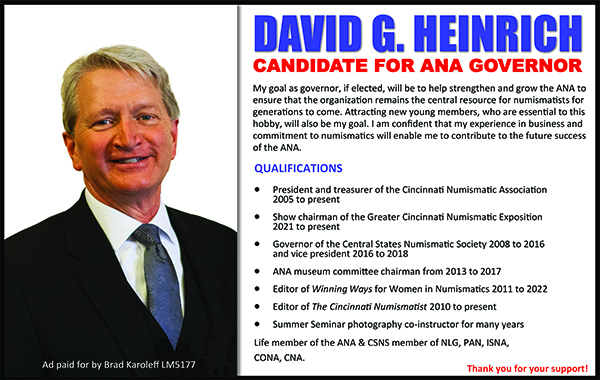
PREV ARTICLE
NEXT ARTICLE
FULL ISSUE
PREV FULL ISSUE
ON WITHDRAWING COINS FROM CIRCULATIONJohn Regitko of Toronto, Canada submitted these notes on the large-scale withdrawal of coins from circulation. Thank you! -Editor In the last E-Sylum, David Pickup, under the heading "New King, New Coins?" stated: "The cost of removing vast quantities of coins from circulation and minting their replacements would be staggering. The only example I can think of in modern times was the recall of Commonwealth coins after the Restoration. I suppose you can understand it as those coins would not have been thought quite nice!" Here are a few updates: The recall of the pre-Euro coins from many countries that joined the European Union was done out of necessity. The coins were waffled and then sold to smelters for melting and repurposing. In June 2003, the U.S. began waffling coins that were quietly being removed from the distribution system. This included Eisenhower dollars, Susan B. Anthony Dollars, the new series of Presidential dollars, Sacagawea dollars, State quarters, Kennedy half dollars, 5-cent Jefferson and 10-cent Roosevelt pieces. They all have one thing in common - the melt value exceeded the face value. The popular round £1 coin of Great Britain was replaced starting on October 16, 2017 with a new 12-sided version. It was not the result of changing its metallic content, size or weight due to its high melt value. It had nothing to do with changing from the British Pound to the Euro dollar...but for a different and very unusual reason. If you are just going to replace one size and shape of a coin with another size and shape of the same denomination, why bother? The reason had to do with the ease of counterfeiting the One Pound coin and being able to spend them without difficulty. This is borne out by the admission of the British Royal Mint that 1.45 million of the £1 coins that were returned to the Mint during the recall were counterfeit. The British Mint said fakes could not be readily distinguished from the genuine coin, which is why a new coin was introduced. In case the logic of replacing the coin escapes you, the Government has admitted defeat in tracking down and bringing criminals responsible for the counterfeiting and the distribution. Instead, they bowed to the success of criminals by withdrawing the round £1 coin. While the reason for replacing the British coin is somewhat unusual, the process of accumulating and destroying the old coins is also unusual in all its simplicity when you compare it to the recall of pre-Euro coins. The Euro countries accumulated the pre-Euro coins at banks and other money handlers across Europe, then waffled the, to demonetize them before shipping them to smelters. In contrast, the U.S. Mint waffled the silver coins themselves in-house before shipping them to smelters. Instead of being accumulated in various locations and waffled before being shipped to a smelter, the £1 coins were shipped directly by the banks in Great Britain, without being waffled, to the Royal Mint in Llantrisant, Wales. They were then melted in-house at the Mint and the metal used to help create some of the replacement £1 12-sided coins. A little known program was instituted in 2004 in Canada following the introduction of multi-ply plated steel (MPPS) coins. Its objective was to cull older-composition coins from circulation and replace them with coins of the new multi-ply plated steel specifications. If the method of cancelling the legal status of coins by waffling worked previously in the U.S. and Europe, why not use it in Canada? The Royal Canadian Mint contracted with Brink's to accumulate the old coins under a project called "Alloy Recovery Program" (ARP) where they segregated the old coins when they sorted, counted and rolled coins coming in from banks and commercial customers, waffled them and waited for instructions from the Mint to which smelter they should be shipped (the Mint obtained bids from smelters for these waffled coins). The Mint also made a deal to segregate pre-MPPS coins with Coinstar (I believe in the Province of Quebec only) to turn over any found in their counting machines and turn them over to Brinks for waffling. Canada's recall of the older pure nickel coins is still ongoing, thanks to the Royal Canadian Mint's ongoing contract with Brinks, although Coinstar is no longer accumulating the older coins due to the cost of seperating versus what the Mint is willing to pay Coinstar. If you want any more details, you will have to wait for my new 800-page letter-size (3-ring punched) book on the workings of the Royal Canadian Mint. I hope to announce the availability of this Covid-project by year-end.
To read the earlier E-Sylum article, see:
Wayne Homren, Editor The Numismatic Bibliomania Society is a non-profit organization promoting numismatic literature. See our web site at coinbooks.org. To submit items for publication in The E-Sylum, write to the Editor at this address: whomren@gmail.com To subscribe go to: https://my.binhost.com/lists/listinfo/esylum All Rights Reserved. NBS Home Page Contact the NBS webmaster 
|
